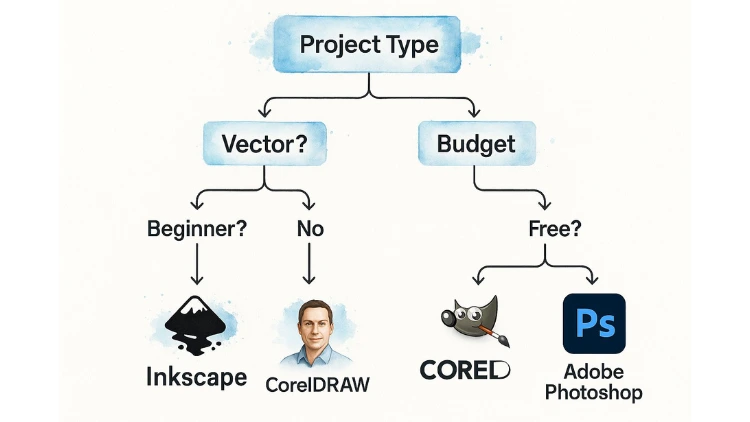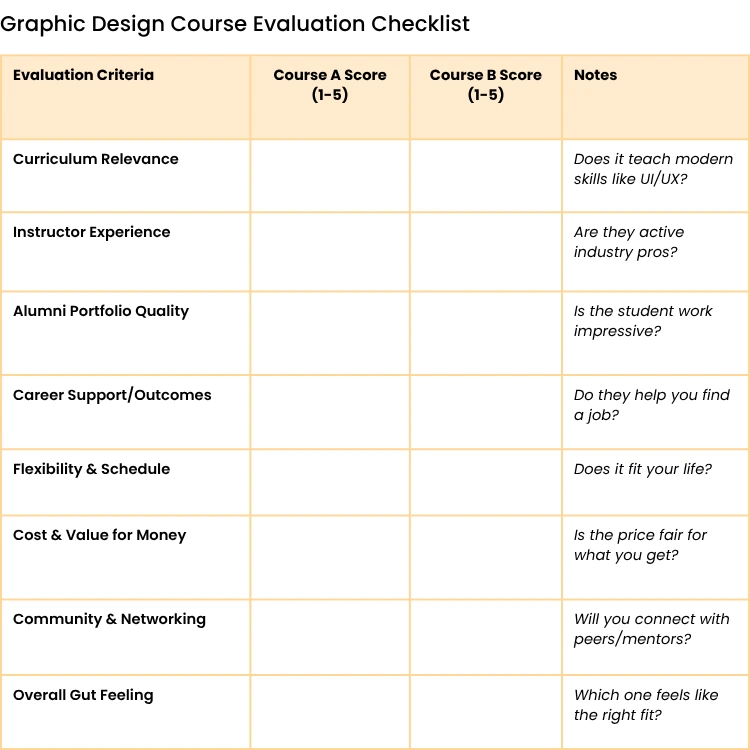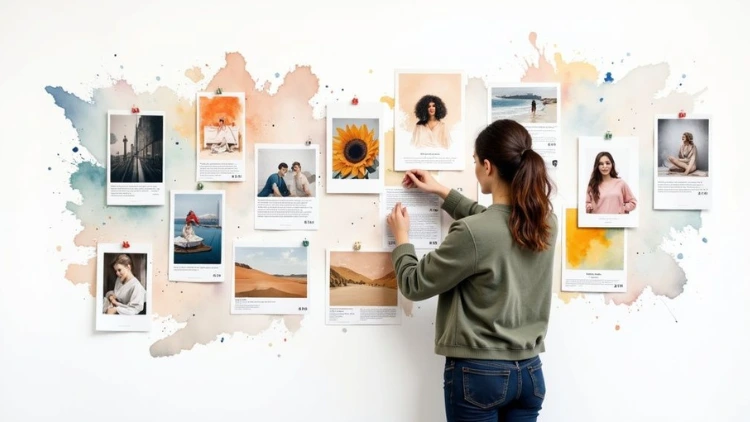Choosing Online Graphic Design Course for Beginners

So, what exactly is a graphic design course? Think of it less like a technical manual and more like a creative apprenticeship. It’s a structured program designed to teach you the art of visual communication, blending artistic theory with the practical skills you need to bring ideas to life.
You’re not just learning software; you’re learning the language of images, colours, and typography.
Actionable insight: Before you even enroll, try a simple exercise. Take a brand you love and one you don't. Analyze their logos, websites, and social media posts. What colors do they use? What feelings do the fonts evoke? This is the kind of critical thinking a course will sharpen.
Jump To Section

Earn As You Learn
Earn 25% commission when your network purchase Uplyrn courses or subscribe to our annual membership. It’s the best thing ever. Next to learning,
of course.
Your Starting Point for a Creative Career
Jumping into a graphic design course is the first real step toward a career that’s both dynamic and incredibly rewarding. The field has exploded in recent years, which just goes to show how vital it is in our visual-first world.
To put it in perspective, universities in the United States handed out around 22,000 graphic design degrees during the 2019–2020 academic year. That's a staggering 83% increase from just a decade earlier. It’s clear the demand for skilled designers is on the rise.
What You Will Actually Learn
A huge misconception is that these courses are just long-winded tutorials for Adobe Illustrator or Photoshop. While you’ll definitely get your hands dirty with those tools, the real heart of your education is learning the timeless principles of design.
These core concepts are what separate a true designer from someone who just knows how to operate the software.
You'll get a solid grounding in fundamentals like:
- Colour Theory: This is all about understanding the psychology behind colour and how to build palettes that feel right and send a clear message.
Practical example: A health food brand might use greens and earthy tones to convey naturalness, while a tech startup uses bold blues and electric purples to feel innovative and trustworthy. - Typography: It’s more than just picking a font. You’ll learn how to arrange text so it’s not only legible but also visually appealing and emotionally resonant.
Practical example: A law firm's website will use a classic serif font to project authority and tradition, while a children's book cover uses a rounded, playful font to seem fun and friendly. - Composition: This is the art of arranging visual elements to guide the viewer’s eye, create balance, and tell a cohesive story.
Practical example: In a concert poster, the band's name is placed at the top in large type, the date and venue are clearly visible in the middle, and ticket information is at the bottom, creating a natural visual hierarchy.
A strong grasp of composition can turn a cluttered, confusing poster into a clear, powerful message. By using principles like the rule of thirds or leading lines, you can direct someone's attention exactly where you want it—like to an event date or a call to action.
Ultimately, a quality program teaches you how to think like a designer. You’ll learn to solve problems visually, taking an abstract client brief and turning it into something tangible and effective.
To see what this looks like in the real world, you can explore the many different specializations within graphic design.
Breaking Down the Core Curriculum
Stepping into a graphic design course is like being handed a brand new creative toolbox. Each part of the curriculum gives you a new instrument, teaching you not just what it does, but how to use it with real purpose and skill. Forget those dry academic checklists; a good, modern syllabus is all about learning to solve visual problems, hands-on.
The first things you'll tackle are always the fundamentals. Think of typography not just as picking out fonts, but as a form of visual storytelling. A common first project might be to adjust the kerning—that’s the tiny space between individual letters—on a logo.
Practical example: Nudging the letters in "WAVE" closer together can make the wordmark feel compact and solid, like a wave's crest, while spacing them out in "S P A C E" creates an airy, open feel.
Mastering Essential Design Skills
From there, you’ll dive into the bigger concepts that really form the backbone of a designer's toolkit. These aren’t just topics you read about; they're skills you have to practice until they become second nature.
- Layout and Composition: This is all about learning how to arrange things on a page so you can guide the viewer’s eye exactly where you want it to go. A typical task is redesigning a messy, cluttered magazine page to create a sense of visual harmony and make it easy to read. To really get good at this, you have to embrace the 8 essential elements of graphic design as your guide.
- Branding and Identity: This goes way beyond just making a cool logo. You'll build an entire visual system for a fictional company, complete with color palettes, typography rules, and mockups.
Practical example: You might create a brand guide for a new coffee shop, specifying how the logo should look on a cup, an apron, and the shop's sign to ensure consistency. - UI/UX Design Principles: As almost everything becomes interactive, understanding the user is non-negotiable. A project here might involve creating wireframes for a new mobile app, focusing on making the user's journey from one screen to the next feel completely natural and intuitive.
A well-structured graphic design course teaches you that every single design choice has a consequence. The color, font, and layout you pick aren't just for looks—they actively shape how a user feels and what they do next.
Preparing for a Digital-First Industry
Today's courses know the industry is digital, so they build in skills for what’s happening right now. Modules in motion graphics will teach you how to bring logos to life or create snappy promotional videos. You’ll also dig deeper into applying core design principles in new ways, like unlocking creativity with fonts for art and design to give your projects more impact. It’s all about making sure you graduate with a versatile skill set that’s ready for the demands of today’s market.
Mapping Your Career Path After Graduation
So you’ve finished your graphic design course—what’s next? Think of it less as an endpoint and more like a launchpad into a creative industry that’s buzzing with opportunity. The skills you’ve picked up are a passport to a whole range of specialized roles that companies are desperate to fill. Your career can branch out in some seriously cool directions.
The abilities you learned are your foundational building blocks. That module on user experience? It’s your direct line to a career as a UX/UI Designer.
Practical example: Instead of just designing a beautiful button, you'd be responsible for deciding where the button goes on the screen so that users can find it effortlessly, improving the app's usability.
Exploring Specialized Design Careers
Once you get your footing, you can start aiming for specific sectors. Many graduates find their groove in roles that mix pure creativity with sharp strategy, producing work that makes a real impact for big brands and ambitious startups alike.
- Brand Identity Designer: You become the guardian of a company’s visual soul. A real-world project might involve creating a full brand guide—logo, color palette, typography—that keeps the company looking consistent everywhere, from a billboard to an Instagram post.
- Art Director: This is where you step into a leadership role, steering the creative vision for a team. An art director at an ad agency could oversee the entire visual campaign for a new sneaker launch, from the first napkin sketches to the final photoshoot.
- Motion Graphics Designer: Your job is to make static designs dance. You could find yourself animating a slick logo for a company's YouTube intro or designing eye-catching infographics that come to life on social media feeds.
The graduates who get hired first are the ones who can show how their classroom projects solve real-world problems. Your portfolio needs to be more than just pretty pictures—it should be a collection of solutions that proves you're ready for the job.
Building Your Professional Portfolio
Let’s be clear: your portfolio is the single most important tool you have for landing a job. You need to shape it for the roles you actually want.
Actionable insight: If you're targeting UI/UX roles, create a case study for each project. Don't just show the final design; explain the problem you were trying to solve, show your initial sketches and wireframes, and describe how your solution helps the user.
As you gear up for the job hunt, remember that portfolio is your ultimate calling card. Check out these effective graphic design portfolio tips to make sure your work gets noticed. It also helps to understand how your skills fit into the wider creative landscape, so take a look at this guide comparing career paths like graphic design vs video editing to see the bigger picture.

How to Choose the Right Graphic Design Course
Picking a graphic design course is a big deal. You're investing serious time and money, so you want to get it right. Think of it like buying your first professional camera—the right one can open up a whole new world of creativity, but the wrong one will just gather dust. The trick is to look past the shiny brochures and dig into what really matters for your learning and your future career.
A good place to start is the curriculum. Get your hands on a detailed syllabus if you can. Does it feel stuck in the past, focusing only on print? Or does it embrace the skills companies are hiring for right now, like UI/UX and motion graphics?
Actionable insight: Search for "junior graphic designer" jobs on LinkedIn in your target city. Make a list of the top 5 skills mentioned in the job descriptions. Now, compare that list to the course curriculum. The more matches, the better.
Evaluate Instructors and Alumni Work
Who is teaching the course? This is huge. You want instructors who are more than just academics; you want people who are actually out there doing the work. Check out their portfolios. Are they active in the industry? A program led by working professionals will give you insights and connections that a purely theory-based course just can't match.
In the same way, the work of past students tells you everything you need to know about a course’s quality.
- Dig into Alumni Portfolios: Don't just skim them. Really look at the work. Do you see creativity? Technical polish? Does it look like they’re solving real-world design problems, or just checking boxes on a generic assignment?
- Look at Career Outcomes: Most good programs will brag about where their graduates end up working.
Actionable insight: Use LinkedIn to search for the school's name and "graphic design". See where alumni are actually working. This gives you unbiased proof of career paths.
This handy decision tree can help you figure out which software skills to prioritize based on what you want to create.
As the graphic shows, what you need to learn—whether it's vector tools for logos or raster software for photo editing—really depends on your goals. Make sure the course you pick focuses on the right tech for you.

Look Beyond Reputation
While a big-name school sounds impressive, its acceptance rate can paint a misleading picture. For instance, Simon Fraser University has a 77% acceptance rate, while New York University is incredibly selective at just 9%. A lower acceptance rate doesn't automatically mean a course is better for you—it often just means it's more in demand. You can discover more insights about top graphic design programs to see how different places compare.
The best graphic design course isn't always the most famous one. It's the one that gives you the specific skills, mentorship, and portfolio pieces you need to land the job you actually want.
To help you systematically compare your options, we've put together a simple checklist. Use this table to score the courses you're considering side-by-side.
This isn't about finding a "perfect" score, but about making a clear-headed decision based on what's most important to you.
Finally, think about the learning experience itself. A well-designed course should be engaging and easy to navigate, not a frustrating chore. For a deeper dive on this, check out this guide on course design questions that impact user experience.

Spotlight on World-Class Design Programs
So, what really separates a decent graphic design course from a genuinely great one? It's all in how they manage to blend timeless design principles with skills that are actually in demand right now. The best programs don’t just show you how to use the software; they rewire your brain to think like a designer, solve problems, and innovate.
These top-tier institutions build their entire curriculum around one core belief: design is a strategic tool for solving real-world challenges. This mindset means every single project, whether it's creating a brand identity from scratch or designing a sleek mobile app, is anchored in a clear purpose.
Practical example: A student project might not just be "design a poster", but "design a poster campaign for a local charity to increase donations by 20%", forcing students to think about goals and results.
Learning from the Best
The most respected programs tend to share a few key ingredients. Once you know what they are, you can use them as a checklist to see how any other course stacks up.
- Project-Based Learning: Forget endless lectures. The focus here is on working with real-world briefs. This hands-on method means you walk away with a portfolio packed with work that proves you can solve actual problems.
- Emphasis on Critical Thinking: The real goal is to sharpen your design intuition. You learn why some layouts feel right and how typography can stir emotion, turning you from a pixel-pusher into a strategic thinker.
- Integration of Technology: The industry is always changing, and leading courses embrace that. They seamlessly weave new tech into the curriculum so you’re ready for whatever comes next.
The most impactful graphic design course won’t just teach you how to design—it’ll teach you how to think like a designer. It elevates you from a creator of visuals to a visual problem-solver.
Just look at some of the leading institutions in Europe. Programs at places like Politecnico di Milano and Aalto University have a reputation for brilliantly merging classic design foundations with cutting-edge tech. As you can see in this breakdown of the 10 best graphic design schools in the world, they put a huge emphasis on critical thinking and practical projects, preparing graduates for dynamic careers in everything from branding to digital media.

Common Questions About Graphic Design Courses
Dipping your toes into the world of graphic design education can feel like navigating a maze. A lot of questions pop up, and one of the biggest debates is whether you really need a formal degree to make it.
While a degree program offers a fantastic, structured way to learn and build a network, the truth is, a killer portfolio is what lands you the job. It's your tangible proof of skill, regardless of how you got there.
Another common fork in the road is the whole BFA vs. BA thing. What's the difference? Think of a Bachelor of Fine Arts (BFA) as a deep dive. About two-thirds of your classes will be hands-on studio work, focusing intensely on the craft. A Bachelor of Arts (BA), on the other hand, is a broader exploration. You'll still get your design education, but it's mixed with a healthy dose of liberal arts courses.
Deciding between them really just comes down to where you see yourself. If your dream is a highly specialized, creative role where you’re deep in the design software all day, a BFA might be your ticket. But if you’re leaning toward roles like art direction or marketing—where big-picture thinking and sharp communication skills are just as important as design chops—a BA can give you a more well-rounded edge.
Essential Skills to Master
No matter which path you take, getting a head start on the industry's go-to software is a smart move. You'll hit the ground running in any course you choose.
- Adobe Creative Cloud: There's no getting around it. You need to get comfortable with Illustrator for vector work, Photoshop for anything pixel-based, and InDesign for laying out documents. These three are the bread and butter of the design world.
- Prototyping Tools: If you have even a passing interest in UI/UX design (and you should, it's a huge field), start playing around with tools like Figma or Adobe XD.
The best designers never stop learning. The software will change, new tools will emerge, but a rock-solid grasp of the fundamentals—things like hierarchy, balance, and contrast—will serve you for your entire career.
On that note, skills that used to be "nice-to-haves" are quickly becoming must-haves. As video continues to dominate online, many designers are realizing why graphic designers should acquire video editing skills. It's just one more way to stay relevant and valuable.
Actionable insight: Download a free video editor like DaVinci Resolve and try creating a simple animated version of a logo you designed. This small project can be a great portfolio piece and shows initiative.
Ready to build the skills for a creative career? Explore a world of expert-led courses with Uplyrn and start your design journey today.


Leave your thoughts here...
All Comments
Reply